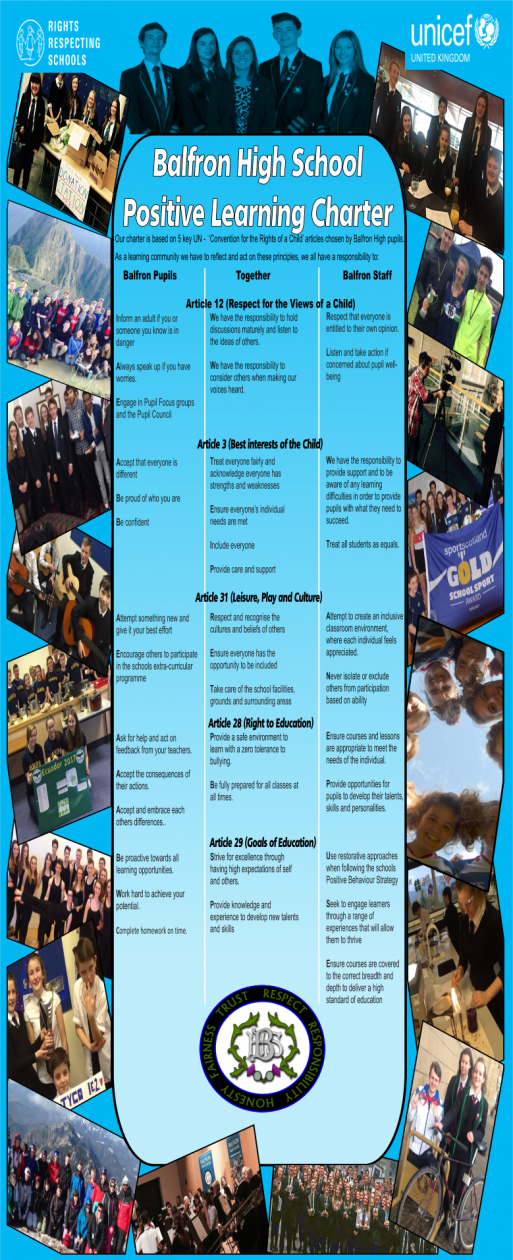
THE AIM OF THE BALFRON HIGH LEARNING CHARTER.
The aim is to make:
- The Convention a real and meaningful guide to action on a day-to-day basis.
- The initial process of creating the learning charter to be inclusive and unite the pupils and adults in the classroom.
- The process an opportunity to develop a sense of ownership of the classroom and learning.
- It a point of reference for the class.
- The charter, once signed by teachers, support staff and pupils a shared enterprise and signify the ‘social glue’ which binds everyone together.
STEPS TAKEN TO CREATE THE LEARNING CHARTER.
In Form Classes we took the opportunity to reflect on the UN Convention on the Rights of the Child (CRC) and then voted individually on those which we deemed as the most relevant to our lives in school / classrooms.
As a pupil group, we selected the following as our top 5 articles:
- Article 29 (goals of education) – Education must develop every child’s personality, talents and abilities to the full. It must encourage the child’s respect for human rights, as well as respect for their parents, their own and other cultures, and the environment.
- Article 28 (right to education) – Every child has the right to an education. Primary education must be free. Secondary education must be available to every child. Discipline in schools must respect children’s human dignity. Wealthy countries must help poorer countries achieve this.
- Article 31 (leisure, play and culture) – Every child has the right to relax, play and join in a wide range of cultural and artistic activities.
- Article 3 (best interests of the child) – The best interests of the child must be a top priority in all actions concerning children.
- Article 12 (respect for the views of the child) – Every child has the right to say what they think in all matters affecting them, and to have their views taken seriously.
All pupils were then given the opportunity to reflect on the five chosen articles taken from UN Convention on the Rights of the Child (CRC) and from that develop a meaningful guide to action on a day-to-day basis in school and beyond. Critically, the charter must take into account the whole school community and reflect on the expectations we have for each other, whether as a teacher, a pupil or part of the wider community.
This was supported by Rights Respecting School Ambassadors who offer guidance and support to each Form Class through the creation process of the ‘Positive Learning Charter’.
Form Class were encouraged to review the rationale behind the Positive Learning Charter and read over / discuss the guidance on the task to complete the school wide Positive Learning Charter. Each pupil then had the opportunity to contribute an expectation they have of themselves or others, linking where possible to a specific chosen UN-Convention for the Rights of a Child article. These contributions were recorded on several blank templates and then collated for further discussions to follow.
Following this, the Balfron High School Senior Ambassadors and Junior Ambassadors for Rights Respecting School got together in the Theatre to collate, review and adapt the work done across a range of Form Classes throughout the session, towards the creation of a ‘Positive Learning Charter’. As part of the school journey towards UNICEF Rights Respecting School Award recognition and level one award, a key outcome was to inform and educate the school community about the UN Convention for the Rights’ of the Child, as well as embodying these principles through the creation of a school based charter. The Ambassador team worked extremely well throughout the day to establish a final template for a new Balfron High – Positive Learning Charter.
PDF Version of Balfron High Schools – Positive Learning Charter: banner-image-1

